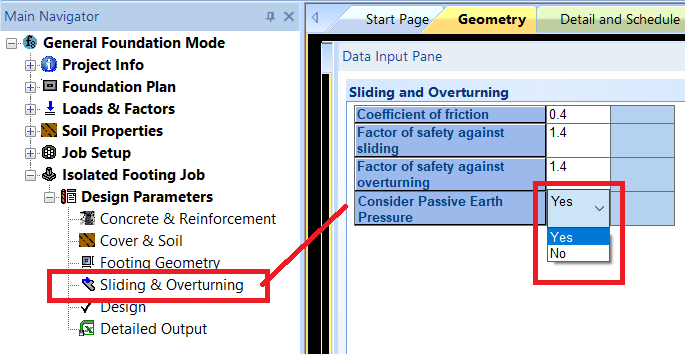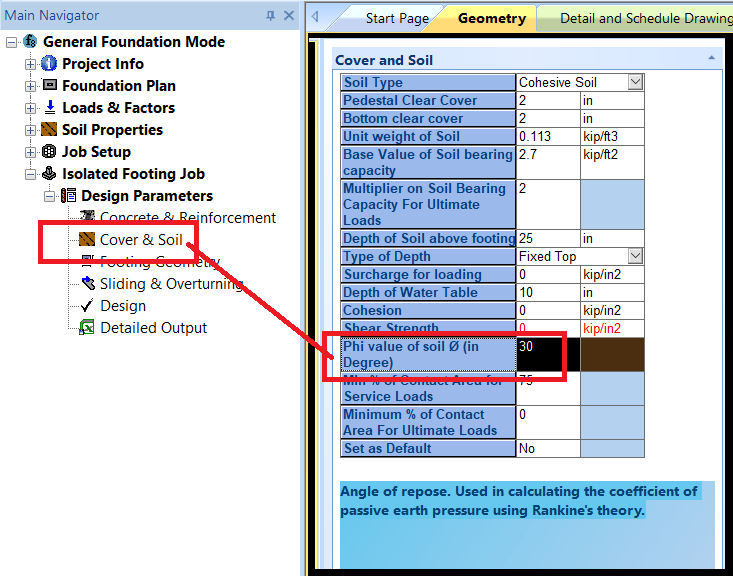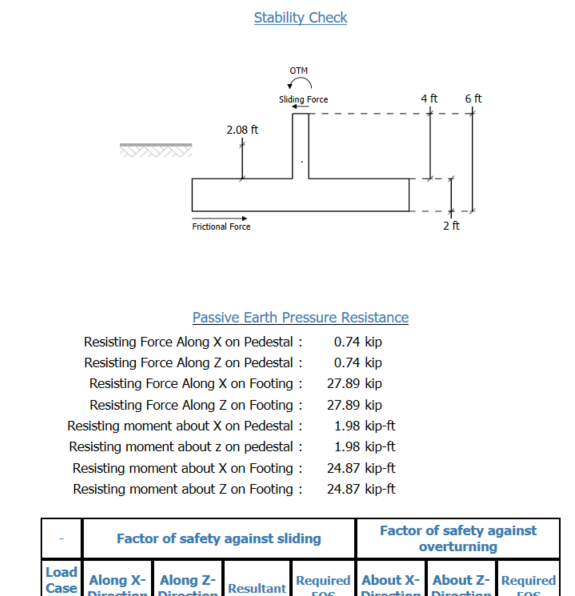Utilizing Passive Pressure Resistance in Overturning and Stability Checks
For isolated footings, the resistance offered by passive pressure of soil to lateral forces and overturning moments can now be considered in the stability calculations.
This is an optional item, meaning, the engineer is given a choice as to whether you want to include this resistance. If you are confident that the foundation system can mobilize this resistance, it can potentially result in savings in the form of a smaller footing if the condition that governs the footing size is stability in overturning and sliding.
The total resistance of the foundation to sliding is calculated as the sum of two terms:
- Frictional resistance at
the base of the foundation = µ × W
where
- µ
= - coefficient of friction between the vertical load acting on the foundation and the soil beneath the footing
- W
= - aggregate vertical load acting on the footing for the individual service load cases. This is obtained as: Load from superstructure to the footing through the column + selfweight of footing + weight of soil on top of footing - buoyancy effect (if any)
- Passive pressure resistance, which consists of two components:
If you choose not to include item 2, the resistance will be obtained from item 1 alone.
Similarly, for stability in overturning, the resisting moment at the base of the footing due to passive resistance is added to the resisting moment due to the vertical loads, W, if you choose to include it.
Procedure used in calculating passive pressure resistance
The passive earth pressure is calculated for each of the 2 horizontal directions (X and Z). The steps involved in this calculation are:
- Calculate the coefficient of passive earth
pressure, Kp, using Rankine's formula:
where
- Φ
= - Angle of repose
- Calculate the force on
the pedestal using the formula:
whereF1 = 1/2 × Kp × γ × h2 × B1 - γ
= - Unit weight of soil
- h
= - Height of pedestal, or, distance from ground level to bottom of pedestal, whichever is smaller
- B1
= - Dimension of the pedestal transverse to the direction of the force. In other words, it is the length or width depending on the direction in which the force due to passive earth pressure is being computed
- Calculate the force on the
footing using the formula:
whereF2 = 1/2 × Kp × γ × (2h+D) × D × B2 - D
= - Thickness of the footing
- B2
= - Dimension of the footing transverse to the direction of the force. In other words, it is the length or width depending on the direction in which the force due to passive earth pressure is being computed.
- Compute the total force due to passive earth pressure as F1 + F2.
- Calculate the resisting
moment at base of the footing due to F1 using the formula
RM1 = F1 × [D + (h/3)] - Calculate the resisting moment at base of the footing due to F2 using the formula:
- Compute the total resisting moment due to passive earth pressure as RM1 + RM2.
The total force and total moment due to passive earth pressure resistance are used in the stability calculations for sliding and overturning.
Program Input for Using Passive Pressure Resistance
There are two terms required to instruct the program to calculate the passive pressure resistance.
In the Sliding & Overturning page, select Yes for Consider Passive Earth Pressure.
In the Cover & Soil page, provide the Angle of repose in degrees. This is used to calculate the coefficient of passive earth pressure using Rankine's formula.
Program Output
In the calculation sheet produced by the program, the output for passive pressure resistance will consist of the following terms:
- Resisting force along X and Z directions due to passive pressure mobilized from the pedestal face
- Resisting force along X and Z directions due to passive pressure mobilized from the footing block
- Resisting moment about the X and Z axes at the base of the footing due to the passive pressure force mobilized from the pedestal and footing block




